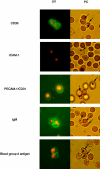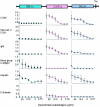The semiconserved head structure of Plasmodium falciparum erythrocyte membrane protein 1 mediates binding to multiple independent host receptors
- PMID: 10880521
- PMCID: PMC1887712
- DOI: 10.1084/jem.192.1.1
The semiconserved head structure of Plasmodium falciparum erythrocyte membrane protein 1 mediates binding to multiple independent host receptors
Abstract
Erythrocytes infected with mature forms of Plasmodium falciparum do not circulate but are withdrawn from the peripheral circulation; they are bound to the endothelial lining and to uninfected erythrocytes in the microvasculature. Blockage of the blood flow, hampered oxygen delivery, and severe malaria may follow if binding is excessive. The NH(2)-terminal head structure (Duffy binding-like domain 1 [DBL1alpha]-cysteine-rich interdomain region [CIDR1alpha]) of a single species of P. falciparum erythrocyte membrane protein 1 (PfEMP1) is here shown to mediate adherence to multiple host receptors including platelet-endothelial cell adhesion molecule 1 (PECAM-1)/CD31, the blood group A antigen, normal nonimmune immunoglobulin M, three virulence-associated receptor proteins, a heparan sulfate-like glucosaminoglycan, and CD36. DBL2delta was found to mediate additional binding to PECAM-1/CD31. The exceptional binding activity of the PfEMP1 head structure and its relatively conserved nature argues that it holds an important role in erythrocyte sequestration and therefore in the virulence of the malaria parasite.
Figures





References
-
- Miller L.H., Good M.F., Milon G. Malaria pathogenesis. Science. 1994;264:1878–1883. - PubMed
-
- Berendt A.R., Simmons D.L., Tansey J., Newbold C.I., Marsh K. Intercellular adhesion molecule-1 is an endothelial cell adhesion receptor for Plasmodium falciparum . Nature. 1989;341:57–59. - PubMed
-
- Robert C., Pouvelle B., Meyer P., Muanza K., Fujioka H., Aikawa M., Scherf A., Gysin J. Chondroitin-4-sulfate (proteoglycan), a receptor for Plasmodium falciparum-erythrocyte adhesion. Res. Immunol. 1995;146:383–393. - PubMed
Publication types
MeSH terms
Substances
LinkOut - more resources
Full Text Sources
Research Materials

